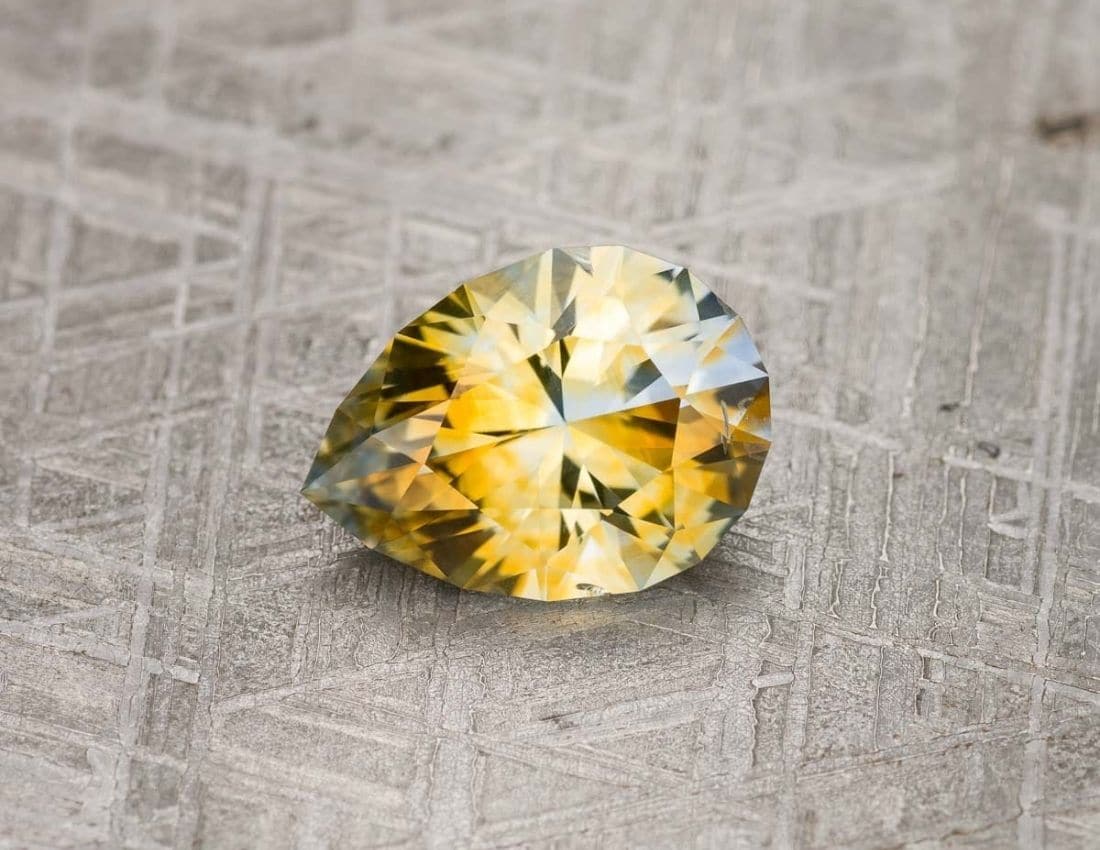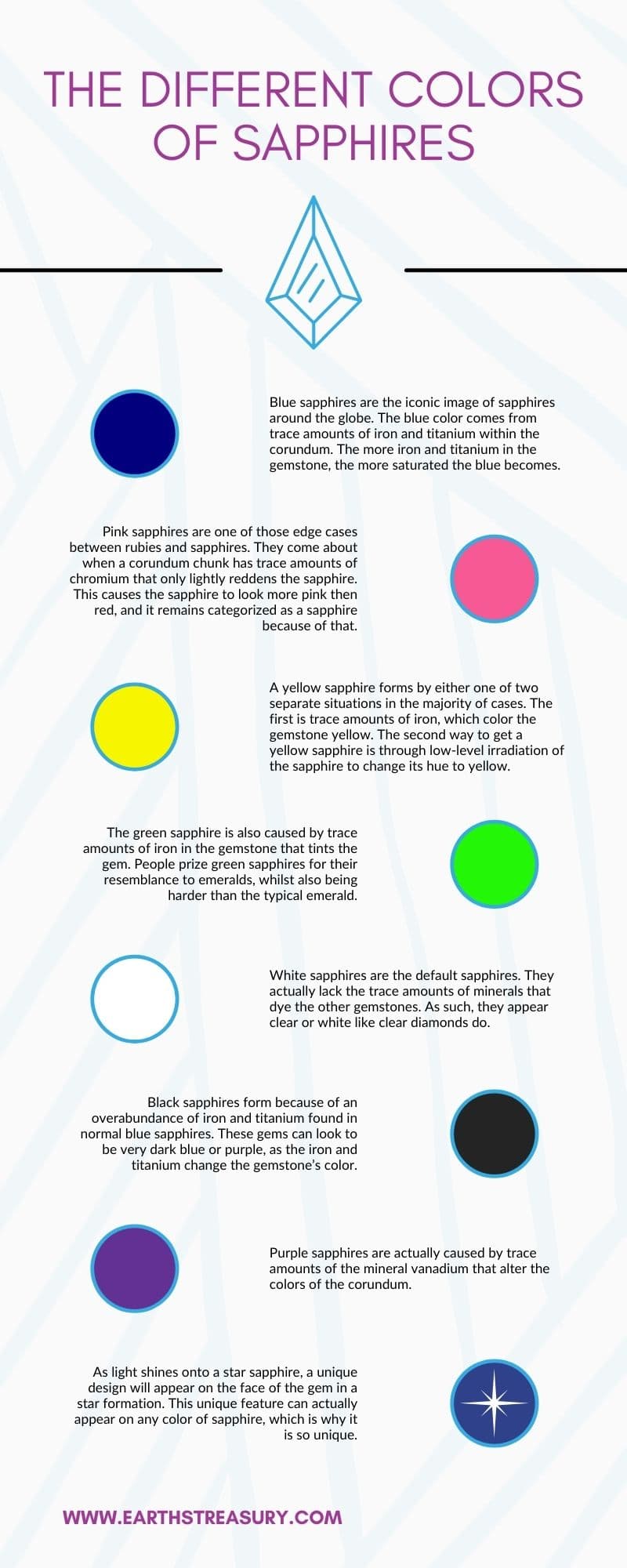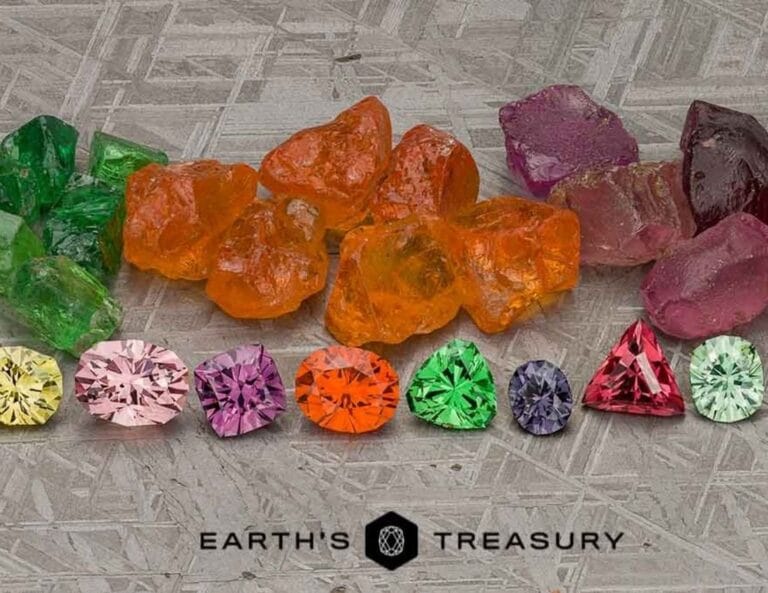The Different Colors of Sapphires
There is a great variety of gemstones in the world, from diamonds to topaz, and all the way to sapphires. However, the different types of gemstones are not the end of the variance, as each gemstone has its own differences and uniqueness. No two gemstones are alike, even more so when looking at sapphires. Most people think of sapphire as a blue gem, but it can actually be a variety of colors: yellow, blue, black, gray, and blue just to name a few. There really is just a huge variety in the different colors of sapphires alone, and we will discuss why they occur.
What Are Sapphires
Sapphires are gemstones mined from the earth, just like any other gem. Coming in many different hues and shades, they rate second only to diamonds in terms of hardness. Their potential for beauty when treated correctly and refined well along with their toughness is what makes them so popular as jewelry. They consist mostly of corundum, along with other trace minerals that stay inside the stone as they form in the earth’s crust.
Why They Are Different Colors
When one thinks of sapphires, the image of a brilliant blue gem often comes to mind. However, this picture is not the whole truth, as sapphires can come in all forms of colors. This is due to the trace amounts of other minerals present in the corundum that sapphires are made from. These trace minerals alter the color of the sapphires, and different minerals change the color in different ways. For example, the blue color in sapphires comes from a mixture of iron and titanium.
Ruby vs. Sapphire
One odd fact about corundum, the mineral that makes sapphires, is that it also makes rubies. This means that rubies and sapphires are actually the same gems, just colored differently because of the trace minerals that change color. This is also the reason why rubies and sapphires have the same hardness on the Mohs hardness scale. Now, the only difference between the ruby and the sapphire is the shade that the corundum takes because of the different amounts of trace minerals. Namely, the more chromium a chunk of corundum has, the redder it becomes. However, there is no standard for the exact amount of red that makes a ruby, and crafters or refiners interpret the gems’ colors subjectively to categorize them. This can create confusion for the edge cases, where a gem might be either a ruby or a sapphire, but most gems are clearly one or the other. A good way to think about the whole situation is that rubies are just red corundum, and sapphires are the rest of the corundum hues.
Various Colors of Sapphires
Each sapphire comes in a different shade, and no two sapphires are the same. However, they do generally fit a category that divides them by color, and sometimes by some other special features. These are the different colors of sapphires.
- As we previously mentioned, blue sapphires are the iconic image of sapphires around the globe. The blue color comes from trace amounts of iron and titanium within the corundum. The more iron and titanium in the gemstone, the more saturated the blue becomes.
- Pink sapphires are one of those edge cases between rubies and sapphires. They come about when a corundum chunk has trace amounts of chromium that only lightly reddens the sapphire. This causes the sapphire to look more pink then red, and it remains categorized as a sapphire because of that.
- A yellow sapphire forms by either one of two separate situations in the majority of cases. The first is trace amounts of iron, which color the gemstone yellow. This yellow can vary in intensity greatly, and some are closer to an orange color. The second way to get a yellow sapphire is through low-level irradiation of the sapphire to change its hue to yellow. This form of yellow sapphire can lose its yellow hue if exposed to too much heat and light.
- The green sapphire is also caused by trace amounts of iron in the gemstone that tints the gem. People prize green sapphires for their resemblance to emeralds, whilst also being harder than the typical emerald. This means that they are really quite desirable for jewelry, as jewelry with sapphires will last longer than one with emeralds under the same conditions.
- White sapphires are the default sapphires. They actually lack the trace amounts of minerals that dye the other gemstones. As such, they appear clear or white like clear diamonds do. These often replace diamonds in jewelry, as they are very similar in looks, while also being generally cheaper.
- Black sapphires form because of an overabundance of iron and titanium found in normal blue sapphires. These gems can look to be very dark blue or purple, as the iron and titanium change the gemstone’s color. These stones are generally cheap as they can be found in large quantities, and they do not let light pass through them.
- Purple sapphires are actually caused by trace amounts of the mineral vanadium that alter the colors of the corundum. Purple sapphires have a few different names depending on where you go, but are universally recognizable for their lovely hue.
- Star sapphires are not so much about the color of sapphires but more about their internal structure. As light shines onto a star sapphire, a unique design will appear on the face of the gem in a star formation. This unique feature can actually appear on any color of sapphire, which is why it is so unique.
Heated Treatment
Although it would be very convenient, gemstones do not come out of the earth without their flaws. Any number of flaws can affect the gemstones’ clarity and color, resulting in a low-grade stone. However quite a few of these flaws can be remedy by special heat treatments that cause the impurities in a gem to diffuse. This heat treatment gets rid of the cloudiness caused by hair-like minerals trapped in gemstones called rutile. Heating the gem can also improve its color, as the minerals melt inside the gem and distribute around the stone. Although not required by law, we here at Earth’s Treasury have signed an ethics code made by the American Gem Trade Association to always disclose if your gem has received treatment, and the type of treatment if it has.
Here at Earth’s Treasury, we have collected and made the best selection of Montana sapphires to give you the best options in both color and clarity of your sapphires. Whether you are looking to buy Montana sapphires for an engagement ring or just want some loose gemstones and jewelry, you will not find a place with a better selection of ethically sourced gems than here.




